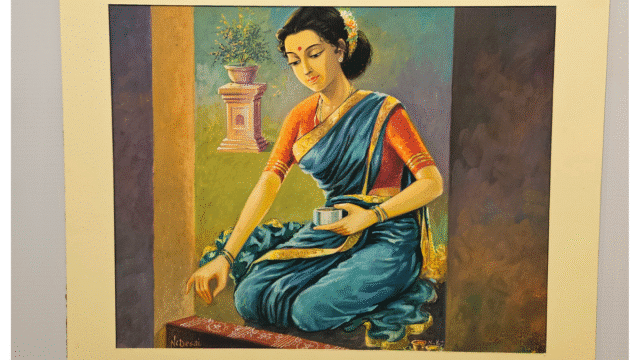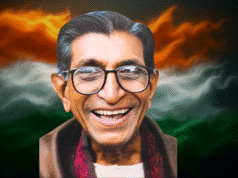A Day That Felt Like Meeting Art Itself
There are days you attend an event, and there are days you feel one.
Today (November 1, 2025), I walked into the N.C. Desai Birth Centenary Painting Exhibition at Vijaya Mahantesh Lalit Kala Mahavidyalaya, Hubli, and for a few hours, time itself seemed to pause.
The N.C. Desai Birth Centenary Painting Exhibition, hosted at Vijaya Mahantesh Lalit Kala Mahavidyalaya in Hubballi, opened its doors today (November 1, 2025) — and what a beautiful sight it was.
Around 120 to 150 art lovers, students, and admirers gathered under one roof to celebrate the life and work of late Shri N.C. Desai, the artist who gave India not just paintings, but perspectives.
Organized lovingly by his immediate family members, the event felt less like a ceremony and more like a reunion — where every brushstroke carried a memory, and every face carried pride.
Art Exhibition Exact Location
Hosted by a Family That Still Paints with Love

This wasn’t a commercial exhibition.
It was a family’s love letter to their father, grandfather, and guru.
Organized by the immediate family of late Shri N.C. Desai, the event carried an energy that was warm, simple, and human.
I had the privilege of meeting his granddaughter and grandson — both incredibly humble souls who carried the same calm grace that reflected in Desai’s art.
They spoke about how this event wasn’t just a tribute, but a way to remind younger generations of what true art stands for — sincerity, culture, and conscience.
A Moment That Stood Out
One of the most touching moments came when one of the chief guests took the stage to speak.
He turned toward Mrs. Desai, the artist’s daughter-in-law who had lovingly organized the event, and said something that drew a quiet nod from everyone in the room.
“In an age where many have forgotten gratitude, here stands a family that remembers its roots. When people today so easily distance themselves from their elders — sometimes even sending them to old-age homes — it brings pride, respect, and hope to see someone honor not just their parents, but their in-laws, by keeping their memory alive through art.”
That line lingered in the air long after the applause ended.
It wasn’t just a compliment — it was a mirror to society.
Art That Still Breathes, Decades Later
Walking through the exhibition felt like entering a conversation between spirituality and realism.
Each painting carried its own rhythm — some spoke of divinity through Lord Ganesha’s universal forms, others whispered the everyday stories of rural India.
The walls were alive with color — not loud, but thoughtful.
You could sense Desai’s journey — from an engineer’s precision to a philosopher’s depth.
And in every corner, you could see the fingerprints of a man who didn’t just paint for fame, but to understand the divine design of life itself.
More Than Paintings — A Legacy
Beyond the canvases, what touched me was the way people stood before each painting — silent, curious, reverent.
Some smiled softly.
Some whispered stories of having met Desai decades ago.
And a few simply closed their eyes — as if trying to capture the feeling in their hearts before leaving.
It wasn’t just an art show. It was a reunion of souls connected by creativity.
The Paintings That Spoke to Me
I’ve captured around 20–30 photographs from the exhibition — each one a world of its own. I am sharing a few with you.
1. Morning Rituals

There’s something deeply peaceful about this painting — a woman lost in the quiet grace of creation, her hand tracing patterns of devotion on the floor. You can almost hear the soft scrape of the rangoli powder, smell the fresh morning air, and feel the rhythm of her calm breath.
N.C. Desai captured not just her form, but her stillness — that sacred moment between chores and prayer, where art and life become one.
2. Blessings Before the Battle
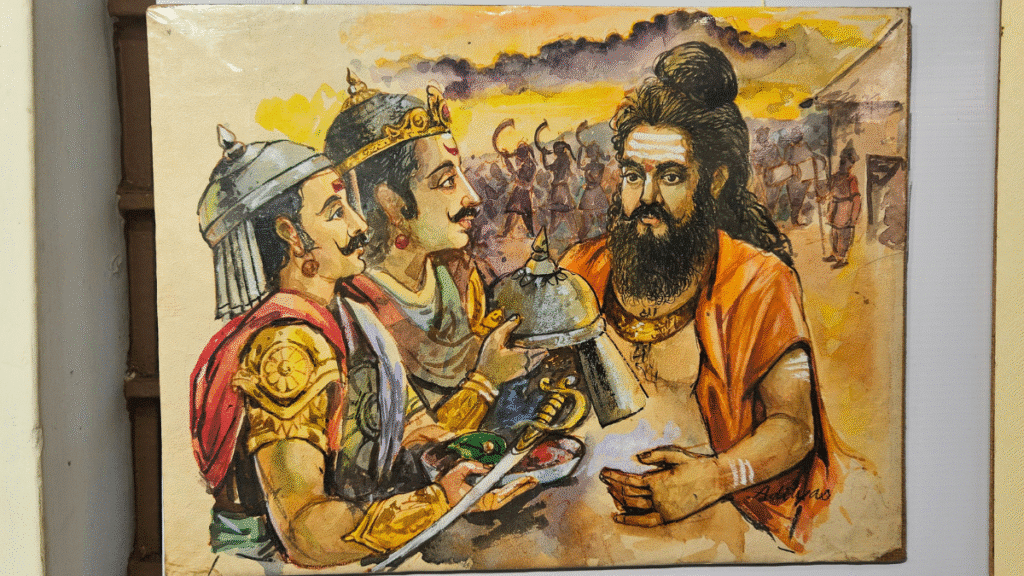
In this powerful composition, N.C. Desai captures a moment every warrior understands — the pause before chaos. Two warriors, armor gleaming and hearts steady, bow before their guru seeking strength, not victory.
The air feels heavy with purpose, devotion, and destiny. You can almost sense the silence — that sacred calm before the storm — as the guru’s gaze carries both compassion and foresight.
This isn’t just a scene of war; it’s a portrait of faith, duty, and the eternal dialogue between power and guidance.
Bhishma on the Bed of Arrows
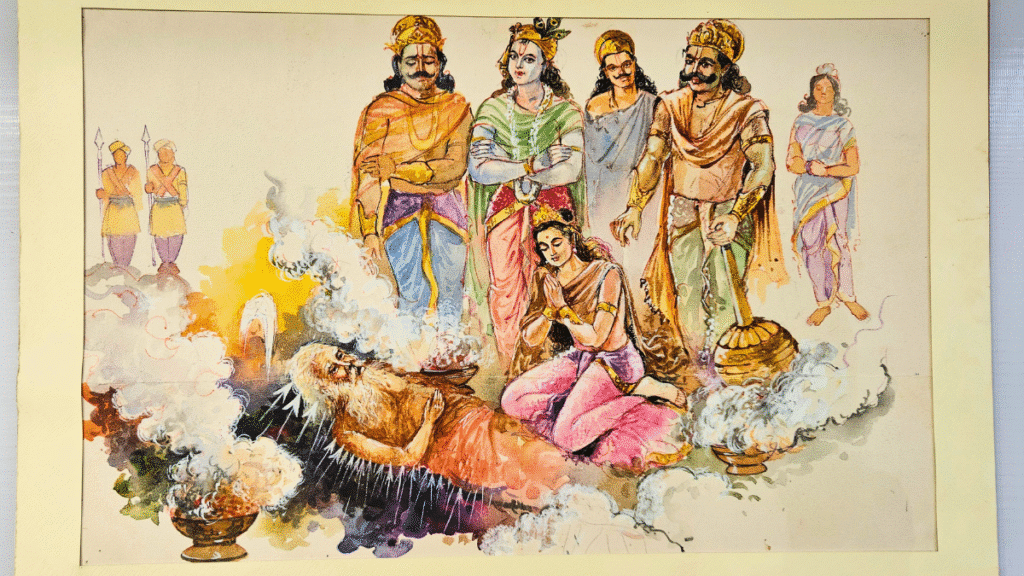
This painting captures one of the most emotional scenes from the Mahabharata — Bhishma Pitamah resting on the Shara Shayya, the bed of arrows. His body, pierced yet unbroken, radiates calm and wisdom even in pain. Around him stand the Pandavas and Lord Krishna, their faces reflecting reverence and sorrow.
Desai’s brush immortalizes not the agony of war, but the dignity of surrender — a warrior’s acceptance of destiny, a saint’s peace in the face of mortality.
The Many Faces of Ganesha
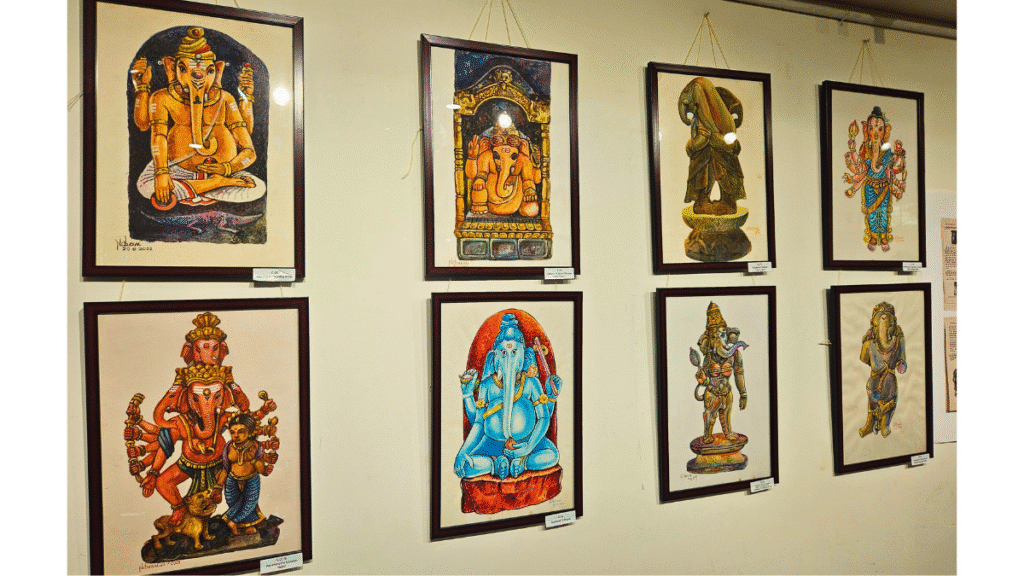
In this mesmerizing series, N.C. Desai reimagines Lord Ganesha through the lens of different cultures and artistic styles — from classical temple forms to globally inspired interpretations.
Each painting carries a distinct rhythm, yet together they hum the same divine tune — of wisdom, joy, and unity.
Desai doesn’t just depict Ganesha; he reminds us that the divine adapts, evolves, and finds its place in every heart, every home, every culture.
Standing before this wall feels like standing before eight conversations with the same God, each speaking in a different artistic dialect — yet all radiating the same light.
Vishvavyapi Ganapati – The Universal Ganesha
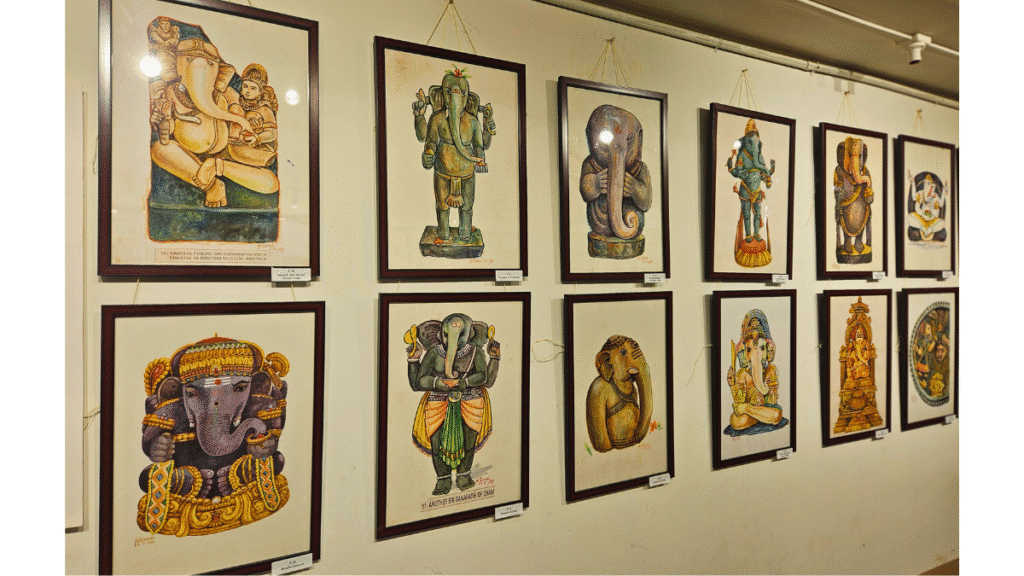
This stunning collection is part of N.C. Desai’s legendary Vishvavyapi Ganapati (Global Ganesha) series, where the artist explored how the beloved elephant-headed deity is revered and reimagined across civilizations.
Each canvas tells its own story — a Thai-inspired Ganesha, a Chola bronze form, a serene temple carving, a Japanese-influenced motif — yet every one radiates the same divine essence of peace and intellect.
Desai painted Ganesha not just as a god, but as a universal symbol of creativity and understanding — a bridge between faith and culture, East and West, past and present. Standing before this wall feels like traveling through centuries of devotion, with Ganesha smiling gently through every age.
Echoes of Ganesha – A Divine Dialogue Through Time

Here, N.C. Desai continues his remarkable Global Ganesha journey — a visual pilgrimage across cultures, emotions, and eras. Each form of Ganesha carries its own heartbeat: some dance with joy, others sit in serene wisdom, while a few stand like protectors at the doorway of faith.
Through his brush, Desai doesn’t simply portray the deity; he invites reflection — reminding us that divinity is not confined to one temple or tradition, but lives wherever creativity and compassion coexist.
Standing before these paintings, you sense not repetition, but revelation — a divine dialogue between art, faith, and time.
Global Forms of Ganesha – From Java to the Himalayas

This final wall in the Vishvavyapi Ganapati series feels like a spiritual world map — Ganesha traveling across civilizations and centuries, yet remaining the same symbol of wisdom and balance.
On the top row, Sri Ganapathi in Diyang sits in radiant orange and gold, his rounded form almost glowing — a gentle reminder of the divine’s playful energy. Beside him, a rare depiction inspired by ancient Javanese art shows Ganesha with elongated limbs and meditative symmetry, reflecting Southeast Asia’s influence on Indian spirituality.
Another frame captures a Thai-styled Ganesha, decked with intricate jewelry and calm eyes — almost human, yet infinitely serene.
On the bottom row, subtler tones tell quieter stories — a stone-carved Ganesha from Java, its ancient simplicity radiating a kind of timeless peace; another, with a blue-hued form, seems to merge sculpture and spirit, capturing Ganesha in contemplative stillness.
This wall isn’t just an art display — it’s an atlas of devotion. Through these paintings, N.C. Desai reminds us that divinity doesn’t travel — it exists everywhere, waiting to be recognized.
The Grace of Yesteryears – Karmaveer Magazine Cover

This painting by N.C. Desai beautifully graced the cover of Karmaveer, a renowned Kannada magazine dated October 11, 1970. The artwork captures the timeless elegance of a traditional Indian woman — her soft smile, poised demeanor, and delicate jewelry reflecting both simplicity and sophistication.
What makes this piece extraordinary is its ability to tell two stories at once — one of the woman herself, and one of the era she represents. The mirror stand, the kumkum box, the flowers, the coconut — each detail whispers of a time when grace wasn’t performed; it was lived.
Desai’s brush turns an ordinary magazine cover into something deeply poetic — a portrait of quiet strength, inner beauty, and cultural pride.
Moments of Warmth – Karmaveer Magazine Cover, 1971
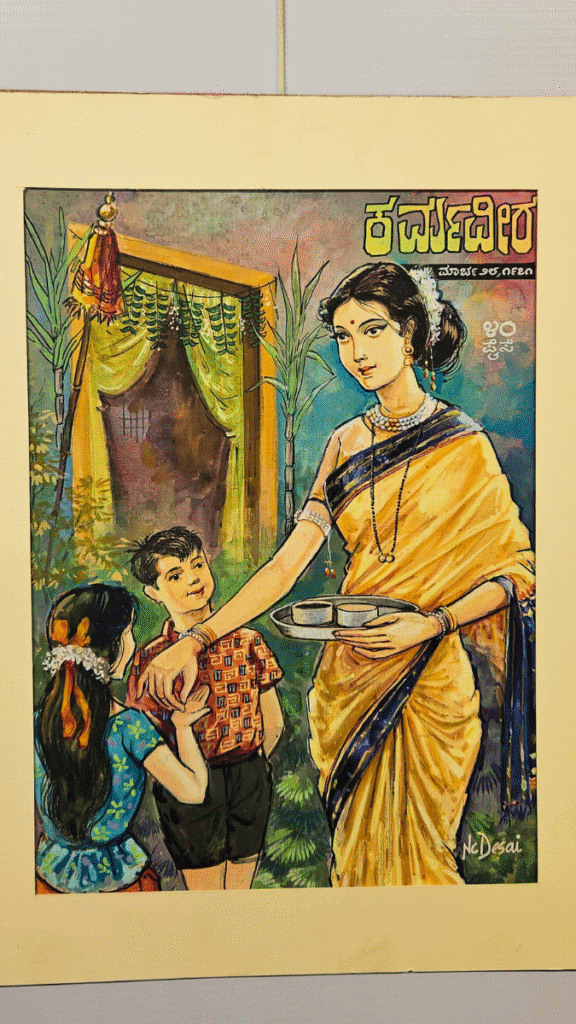
This charming artwork by N.C. Desai adorned the cover of Karmaveer on March 28, 1971, priced at just 40 paise — a time when stories, values, and art shared the same pages.
The painting captures a tender domestic scene: a graceful woman in a yellow saree offers arati and sweets to two children at what appears to be a festive doorway. The sugarcanes, hanging toran, and soft lighting breathe the essence of Indian hospitality and celebration.
There’s something timeless about this moment — the innocence in the children’s faces, the mother’s quiet smile, and the warmth of tradition that wraps around them like sunlight.
Desai didn’t just paint an image; he captured how home felt — safe, loving, and full of small rituals that made life beautiful.
The Unfinished Meditation – Swami Vivekananda
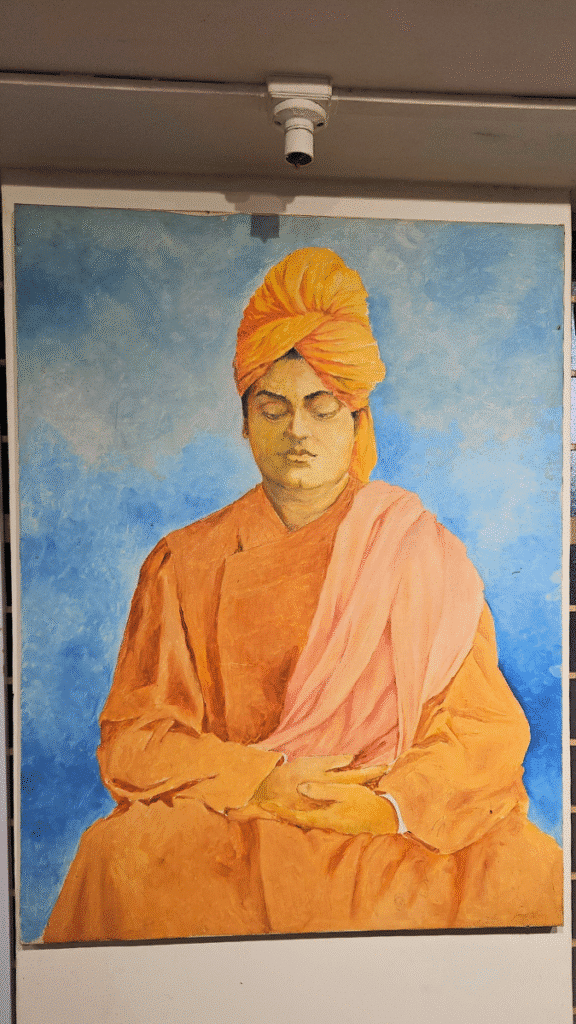
This serene portrait of Swami Vivekananda stands apart — not only for its spiritual depth but also for what it represents: incompletion.
N.C. Desai’s grandson shared that this painting was left unfinished. The artist had a ritual — once a painting was complete, he would sign his name in the corner, marking it as his final word. And from that moment onward, he would never touch it again.
But this one, you’ll notice, bears no signature.
Perhaps it was left intentionally so — a quiet surrender, a reflection of the monk’s eternal meditation, beyond finality.
The stillness in Vivekananda’s closed eyes, the soft blending of saffron and pink robes against the sky — everything about it feels complete in its incompleteness.
There’s a haunting beauty here — as if Desai’s brush paused mid-prayer, leaving behind not just a portrait, but a conversation between the artist and the divine.
The Silent God
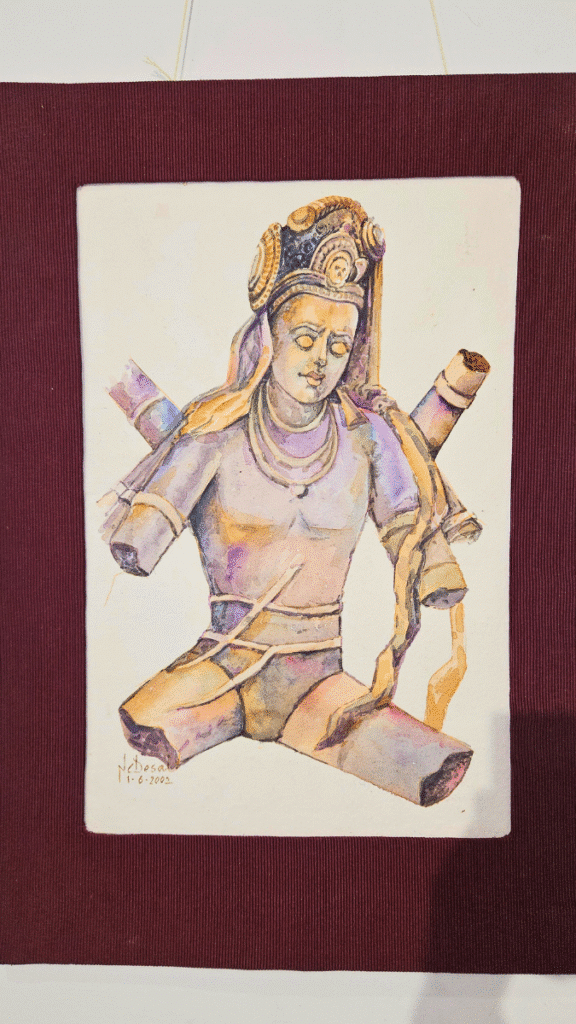
This painting by N.C. Desai feels less like art and more like a moment of mourning.
A once-majestic deity now stands fractured — arms missing, limbs cracked, yet the face… serene, unshaken. The closed eyes seem to whisper, “Even when form is lost, spirit remains.”
Painted on June 1, 2002, this work almost foretells the fragility of time. Desai doesn’t show destruction with violence — he paints it with compassion. Each brushstroke feels like a prayer for what once was: a temple forgotten, faith weathered, but divinity still breathing quietly through the ruins.
There’s something profoundly human in this broken idol. You can sense Desai’s empathy — he wasn’t just painting stone; he was painting the endurance of the sacred.
Even in pieces, the god doesn’t fall — he waits.
The Legacy Lives On – N.C. Desai Digital Archive
Open your camera and scan the QR code to access more than 10,000 pages of N.C Desai’s life work.

Art doesn’t end when the brush stops — and N.C. Desai’s journey proves that.
Thanks to the Servants of Knowledge collective, more than 10,000 pages of N.C. Desai’s life work — paintings, writings, photographs, magazine covers, and unpublished notes — have been lovingly digitized and preserved.
Visitors at the exhibition can simply scan the QR code with their phone cameras to step into this digital treasure trove. Each file feels like a conversation with the artist himself — you can see his evolution, his influences, and even his handwritten thoughts on art and culture.
What’s most moving is that this project is still a work in progress — a reminder that art, like memory, never truly ends. Every scan, every shared link, every view adds one more heartbeat to Desai’s legacy.
It’s not just an archive — it’s a bridge across generations, ensuring that the man who once painted the soul of India continues to inspire its future.
Where Time Meets Canvas
As I stepped out of the gallery, one thing became clear — N.C. Desai never really left. His art, scattered across decades, still hums softly through every color and brushstroke.
From the calm gaze of Swami Vivekananda to the vibrant echoes of his Global Ganesha series, and from broken deities to smiling magazine covers — every painting felt like a page from his diary, written not with ink, but with emotion.
Meeting his family — his granddaughter, grandson, and the humble hands that carried his memory forward — reminded me that art isn’t made of paint and paper. It’s made of love, legacy, and the quiet decision to remember.
And now, with his Digital Archive, his spirit continues to flow — not confined to walls, but alive in every screen, every heart that still believes art can heal, inspire, and outlive us all.
In that moment, I understood what Desai’s silence was saying through his paintings:
“Art doesn’t die. It simply changes its canvas.”
Author’s Note
Written by Vikas Solanke, a passionate admirer of art and culture, who attended the N.C. Desai Birth Centenary Art Exhibition in Hubballi on November 1, 2025. These reflections come not from a reporter’s desk, but from a visitor’s heart — someone who stood before Desai’s paintings, listened to their silence, and walked away a little more inspired.


